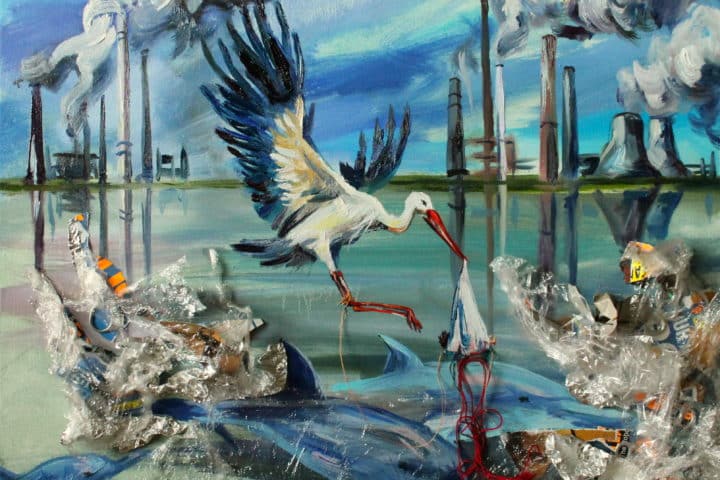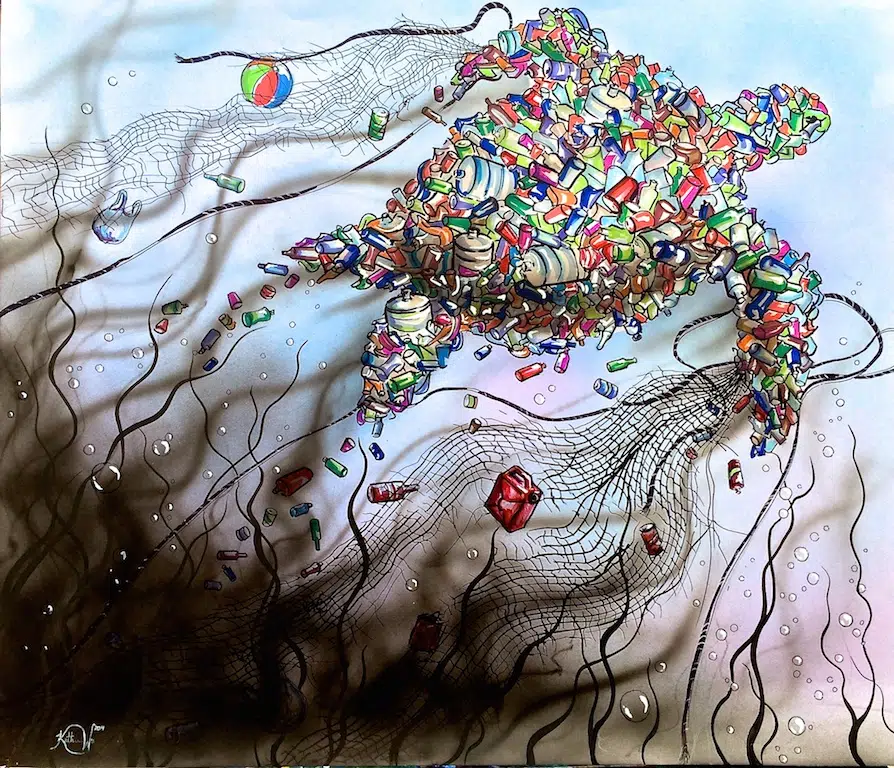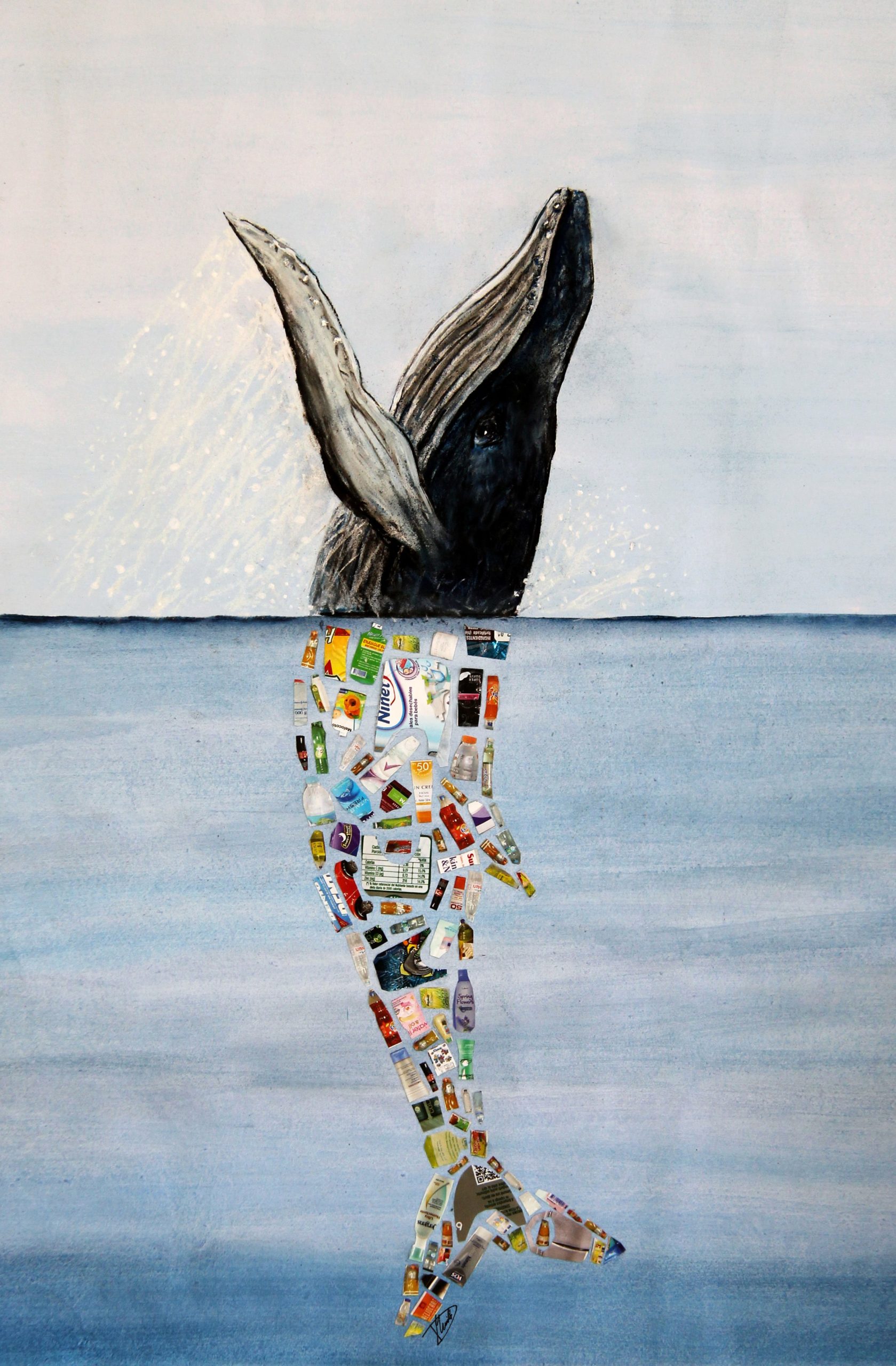
Scientific Innovation in Plastic Pollution and the Role of Taking Climate Action Through the Creative Arts
December 8, 2023By Sarah Robison, 2023 Future Blue Youth Council member
Featured Image: By Michelle Huang (Texas)
You may be familiar with the issues of climate change and plastic pollution, but did you know that the two topics intersect? Increased amounts of greenhouse gas emissions in our atmosphere are absorbed by the ocean and contribute to ocean acidification. This absorption of heat poses a risk to marine health and environmental dynamics, and causes problems like coral bleaching that leads to habitat and nutrient loss for many fish species and sea creatures. Plastic pollution accelerates the warming of waters by preventing the proper absorption of carbon dioxide by water. Read more and watch this fun and educational video about the connection between plastic pollution and climate change.
In recent decades, the severity of plastic pollution has become increasingly apparent because excessive plastic production, increased single-use plastic use, and the littering of plastic debris have risen on a global scale. Statistical analysis shows that plastic pollution has been doubling every six years.

Thankfully, there is growing research about how to tackle existing plastic pollution in our oceans. These studies expand beyond individual actions and group clean-up initiatives to focus on widespread solutions and the creation of science-backed action plans. Since plastic pollution is a critical issue that contributes to climate change, let’s explore a few recent, global developments.
The Swiss Federal Institute for Forest, Snow and Landscape Research WSL recently observed unique microbes located in the Arctic and the Alps, known as extremophiles, that consume certain types of plastic debris that commonly end up in the environment. These microbes may even aid in slowing the melting of low-temperature areas like the Arctic over time. The next challenge will be to identify the plastic-degrading enzymes produced by the microbes so we can produce them on a large scale. “In addition, further modification of the enzymes might be needed to optimize properties such as their stability,” adds Beat Frey, co-author of the study.
In 2016, a plastic-digesting enzyme named PETase was discovered. Bacteria use PETase to break down the carbon molecules in polyethylene terephthalate (PET), a thermoplastic polymer resin that makes up most plastic material, to use it as a primary energy source. Scientists have now been able to modify PETase to digest PET 20% more efficiently. Other solutions such as plastic-digesting mushrooms to degrade polyurethane and magnetic coils to trigger the safe breakdown of microplastics have been in the works. Learn more about beneficial plastic-eating microbes, written by Future Blue Youth Council member Emily.
These are inspiring developments that can reduce the impact that plastic debris imposes on ocean life, marine chemistry, and global warming. If there is less plastic in the ocean, and fewer plastic products produced and distributed, we can keep our waters clean and allow for a healthier marine environment.

Untitled Art by Katharine Wu (Connecticut)
Daily actions such as using reusable bags and bottles, choosing paper alternatives when they’re available, and participating in beach clean-ups play a large role in the fight against plastic pollution and climate change! Participating in ocean advocacy, and using available platforms to raise awareness among others, can make a big difference in ensuring the health of our planet. Read more about the importance of youth leadership in environmental activism.
The creative arts are a powerful tool to raise awareness and inspire individuals to take solutions-focused action. Consider using your favorite medium to convey the importance of reducing plastic use and lessening your global carbon footprint. Dynamic colors in an art piece can evoke a sense of urgency in the viewer; song lyrics can spur the listener to stand up for our planet; the placement of meaningful words can empower a reader to get involved. Through creative advocacy, you have the potential to provoke critical thinking among youth and create a lasting difference for our environment that extends beyond your generation.
Feeling inspired? Utilize your creative side as a call to action. Enter a submission in the Bow Seat Ocean Awareness Contest this year! The 2024 Contest invites you to tell your personal climate story. Remember, if you do choose to address plastic pollution in your piece, be sure to connect it back to climate change.
Will you use your creativity to advocate for the future?

“Plastic Whale” by Dafne Murillo (Peru)
